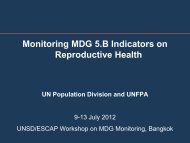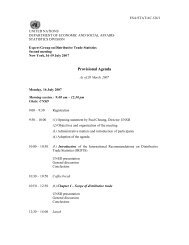demographic yearbook annuaire demographique 1951
demographic yearbook annuaire demographique 1951
demographic yearbook annuaire demographique 1951
Create successful ePaper yourself
Turn your PDF publications into a flip-book with our unique Google optimized e-Paper software.
ates of less than 1 per 1,000 in 14 of the 17 countries. Areas<br />
ofless favorable mortality record rates as high as 8 per 1,000.<br />
Between the ages of 15 and 45 years death rates in the<br />
same group of 17 countries showed decreases of one-third to<br />
one-half, a few decreasing by more than two-thirds. The<br />
percentage of decrease tends to diminish with the advance<br />
of age, reductions in the age group 20-24 being generally<br />
higher than reductions in the age group 40-44. The level<br />
of mortality at these ages is low, the maximum rate at age<br />
40-44 being 5.6, the minimum 2.4, for the terminal years<br />
of the series.<br />
The relative decrease in the age groups between 45 and<br />
65 during the period under consideration was generally less<br />
than one-third, and in a significant number of cases less<br />
than one-tenth. Absolute decreases, however, were larger<br />
than at the younger ages. In a few isolated instances there<br />
were very small percentage increases in the male rates at<br />
ages above 50 but such changes are probably without significance<br />
and no doubt indicate either that the current rate is<br />
about the same as at the beginning of the period, or that<br />
the basic statistics are not fully comparable. Even at these<br />
ages the level of the death rates remains quite low, ranging<br />
from about 4 per 1,000 to less than 8 per 1,000 in the age<br />
group 45-49 and continuing well below 20 per 1,000 until<br />
age 60. In six of the seventeen countries the terminal rate<br />
was still below 20 per 1,000 in the age group 60-64. This<br />
contrasts with rates close to 50 per 1,000 in countries of less<br />
favorable mortality.<br />
Above age 65 relative decreases are much less striking<br />
but in several countries (e.g. Denmark, France, Northern<br />
Ireland) a decrease of approximately one-fifth occurred in<br />
the age group 65-69.<br />
Some of the countries showed increases in death rates at<br />
ages above 75. With the sharp reductions in mortality at the<br />
young and intermediate ages, it is not to be expected that<br />
the mortality rates among the aged population can show<br />
much decline. As increasing proportions of the population<br />
survive to older ages the rates in the terminal age groups are<br />
bound to rise eventually. Death rates rise very rapidly from<br />
about age 65, increasing from a level of approximately 30<br />
to 40 per 1,000 to a level of about 200 per 1,000 at age 85<br />
and over. The age composition of the population within<br />
these age groups, in combination with the sharp rise in<br />
mortality, has an important effect on the rates. The distribution<br />
by single years of age (approximating a rectangular<br />
shape in these low mortality countries) means that the<br />
higher death rate of the older persons within the age group<br />
has a strong effect on the rate for the age group as a whole.<br />
This is the same phenomenon, though on a smaller scale,<br />
that was discussed in connection with the crude death rate.<br />
The reliability of statistics at the advanced ages is open<br />
to some question. Even in countries with generally accurate<br />
data, numbers are smaller at these ages and the accuracy<br />
of age-reporting is probably subject to considerable error.<br />
Differences between the low mortality countries and the<br />
high mortality countries are less marked at the advanced<br />
ages than at the younger ages. Because of the dubious quality<br />
of the data, quantitative comparisons are not attempted.<br />
Some attention should be given to changes in mortality<br />
during the years of the recent war. The countries for which<br />
annual data are available are again those with generally<br />
low death rates. The European countries most directly<br />
affected by the war (e.g. England and Wales, Netherlands,<br />
France) experienced increases during that period at most<br />
ages. These increases occurred among infants, young children<br />
and women as well as among males in the military<br />
ages. Even Sweden, a non-combatant country, showed mild<br />
increases at some ages. These temporary rises were followed<br />
by a quick postwar decline which appears to have brought<br />
the rates back into line with prewar trends.<br />
In combatant countries farther removed from the scene<br />
of military operations (e.g. Australia, the United States)<br />
death rates other than those of males in the military ages<br />
followed a comparatively smooth downward trend.<br />
Sex differences. It is a recurrent phenomenon in the mortality<br />
patterns of most countries which have generally adequate<br />
statistics that male death rates are higher than female<br />
rates. The basic causation of this differential is not clear,<br />
but it seems likely that the disparity cannot be explained<br />
entirely by environmental factors, since it appears at the<br />
very earliest ages and persists to the oldest ages. Even prenatal<br />
deaths are predominantly male, if reliance can be<br />
placed on the statistics of stillbirths.<br />
Among the countries for which data on infant mortality<br />
are shown in table 21, male rates are higher than female<br />
rates almost without exception. The few exceptions that do<br />
occur appear to be attributable to the chance fluctuations<br />
of small numbers or to a temporary loss of efficiency in the<br />
registration system during World War II.<br />
Some of the countries for which age-specific death rates<br />
by sex are presented in table 17 show rates that are higher<br />
for females than for males in the ages past infancy. These<br />
areas are among those which have higher general mortality.<br />
The appearance of the excess in the female rate usually<br />
occurs in the age group 15-19 and continues to age 40 or<br />
45, no doubt reflecting the inroads of maternal mortality.<br />
This reversal of the differential that is currently observed in<br />
countries of low general mortality agrees with similar reversals<br />
in the earlier statistics of these same countries.<br />
Apparently the conquest of maternal mortality has so reduced<br />
female death rates in the child-bearing ages that a<br />
former excess in the female rates has beel1 superseded by an<br />
excess in the male rates.<br />
According to the statistics of many countries, the gap<br />
between male and female rates has tended to increase in<br />
recent times. This is clearly true with respect to the 17<br />
countries for which statistics are shown in table G. Percentage<br />
decreases in female age-specific rates are consistently<br />
larger than those for males. No doubt environmental factors<br />
in an industrial society make some contribution to this<br />
increasing differential. Male death rates from such causes<br />
as accident and suicide, and from conditions that are evidently<br />
associated with occupational hazards, are significantly<br />
higher than female rates from such causes.<br />
Death rates of women in the oldest age groups are frequently<br />
higher than those for men, but this is explainable<br />
in terms of the distribution of the population among the<br />
grouped ages. In the age group 85 and over, for example,<br />
the women have a higher average age than the men. Consequently,<br />
the rate for the age group as a whole is higher<br />
for women.<br />
CAUSES OF DEATH<br />
Statistics on causes of death are exposed to still more<br />
imperfections than are vital statistics in general. The particular<br />
problems of accuracy and comparability that apply<br />
to these data are discussed in some detail in Chapter II.<br />
Faulty as may be the statistics on causes of death, they<br />
nevertheless suffice to demonstrate the different patterns of<br />
"how people die" in areas having high mortality as com-<br />
15













